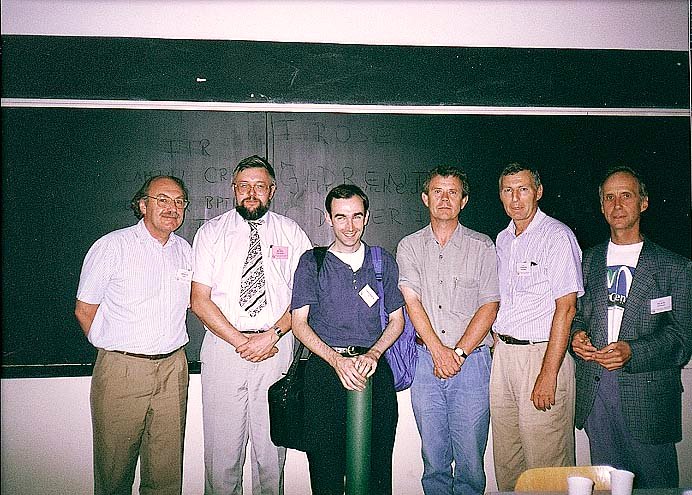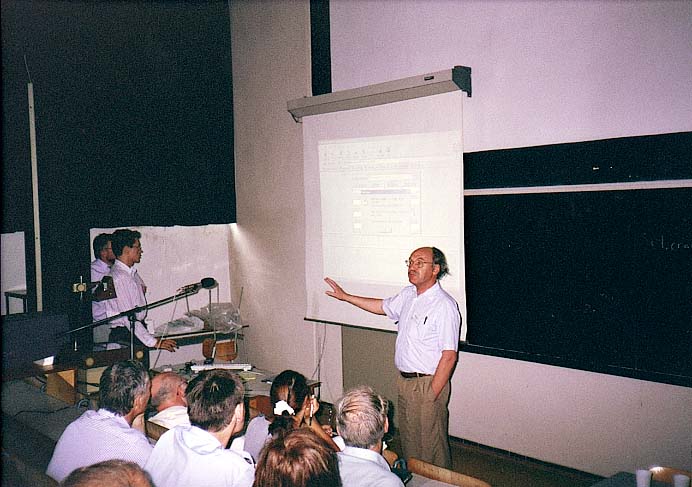 |
Chair: Alan W. Hewat (France), Co-chair: Howard Flack (Switzerland)
| D. Richard, G.J. Kearley | Running Programs at Central Facilities over the Internet | A |
| G. Chapuis, W. Hardaker | Towards a Web-based Interactive Course on Crystallography | A |
| L. Cranswick | Canning the Crystallographic INTERNET | A |
| F.H. Allen | Structure Databases on the INTRANET/INTERNET | A |
| A. Hewat | A Demonstration of the Full ICSD for WWW Inorganic Structure Databases | A |
 |
The ECM-18 Microsyposium "The Internet in Crystallography" consisted of 5 lectures and real-time demonstrations. G.J. Kearley and D. Richard of ILL Grenoble showed how the WWW can be used to provide a graphic user interface for running data analysis programmes on a remote central server (http://barns.ill.fr ). The advantages are that the user does not install any new software, and can use any type of computer. Updating the software on the central server is of course much easier than sending updates to all users. The WWW server uses Java to create the local user interface, and to treat the results, which can be returned as images of plots, postscript or VRML files etc. This BARNS interface was demonstrated by video projection from a local computer running both the server and the WWW client. Gervais Chapuis and Wes Hardaker from the University of Lausanne then demonstrated an interactive WWW course on crystallography called "Discovering Symmetry" (http://www-sphys.unil.ch/symmetry/ ), which again uses Java. This beautiful demonstration showed how even a non-crystallographer could discover the effect of symmetry transformations. Such applications also serve to publicise crystallography to the wider community. After the break, Howard Flack, as chairman of the IUCr committee on electronic publishing, spoke about the IUCr on-line information service (http://www.iucr.org/ ) in its current form and future developments. The service is now mirrored in many countries. Yet some regions of the world are poorly served by the internet, and even in Europe access speed may be a problem. Lachlan Cranswick, CCP14 Secretary at Daresbury Laboratory, demonstrated his NEXUS CD-rom collection of the best of the crystallographic internet, containing large numbers of html pages as well as many crystallographic programmes (http://www.unige.ch/crystal/stxnews/nexus/index.htm ). Frank Allen from the Cambridge Crystallographic Data Center (http://www.ccdc.cam.ac.uk/ ) pointed out that the CSD can only be accessed via the Internet under controlled circumstances within certain countries. The main reasons for this limitation are not technical, but concern copyright, licensing and cost-recovery issues. However Frank was more optimistic about the use of the internet to capture new crystal structure data. Electronic depositions to the PDB are already mandatory, and CIF depositions to the CSD and ICSD are rapidly increasing. Finally, Alan Hewat from ILL, standing in for an invited speaker who could not attend, spoke about the ICSD-for-WWW interface (http://www.ill.fr/icsd/ ) which allows full access to the Inorganic Crystal Structure Database within a laboratory, or within a country. Instead of installing the database on individual PC's it is installed on a central server, which also provides the graphic user interface and the tools for generating 3D drawings, indexed plots of powder patterns, bond length and valence-bond calculations etc. The central server is easier to maintain, can be accessed by any type of computer, and the interface and tools are in some ways more modern than the standard PC version.
A. Hewat, Chair
 |
 |